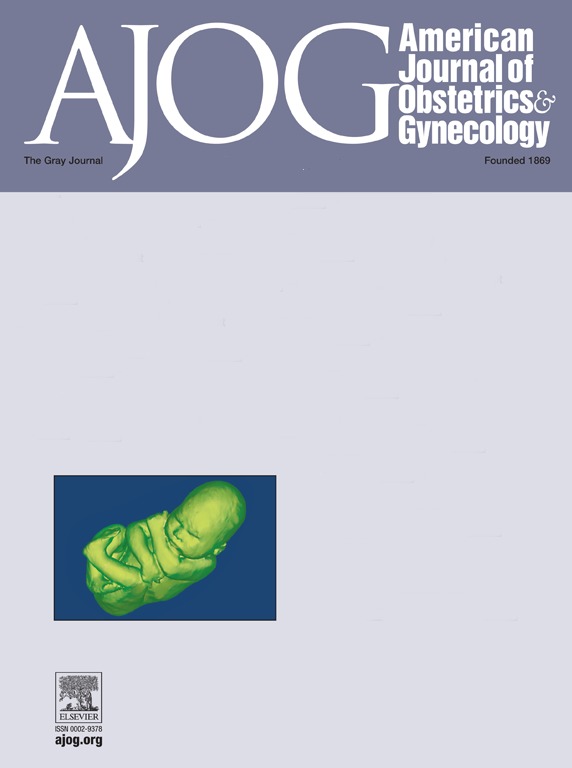剖宫产极早产儿的脐带管理。
IF 8.4
1区 医学
Q1 OBSTETRICS & GYNECOLOGY
引用次数: 0
摘要
背景:延迟脐带夹紧可降低早产儿死亡率。然而,对于剖宫产和阴道分娩是否同样有效,存在争议。目的比较剖宫产后延迟脐带夹紧术与阴道分娩后和剖宫产后早期脐带夹紧术的极早产单胎婴儿死亡率和短期预后。研究设计:我们对2015年1月至2022年12月期间在加拿大新生儿网络(Canadian neonatal Network)各单位住院的<29周妊娠早产儿的孕产妇、围产期和新生儿数据进行了全国性的回顾性研究。我们评估了延迟脐带夹断(≥30秒)的比率和趋势,并将剖宫产后接受延迟脐带夹断的婴儿与:(a)阴道分娩后接受延迟脐带夹断的婴儿和(b)剖宫产后早期脐带夹断(< 30秒)的婴儿进行了比较。我们的主要结局是住院死亡率/严重脑损伤(定义为3/4级脑室内出血和/或脑室周围白质软化)。采用广义估计方程的多变量回归模型,在调整了潜在的混杂因素后,对每个站点内婴儿的聚类进行了解释。结果6137例新生儿中,剖宫产后延迟夹脐带1952例(31.8%),阴道分娩1804例(29.4%),剖宫产后早期夹脐带2381例(38.8%),中位(IQR)胎龄分别为27(25,28)、26(25,28)和26(25,28)周。在剖宫产分娩中实施延迟脐带夹紧术的比例从2015年的32%缓慢增加到2021-2022年的50%。在对潜在混杂因素进行调整后,剖宫产后接受延迟脐带夹断术的婴儿死亡率/严重脑损伤的复合几率[281/1952(14%)]低于阴道分娩后接受延迟脐带夹断术的婴儿[347/1804 (19%)];aOR (95% CI): 0.69(0.54, 0.87)和剖宫产后早期脐带夹断组[543/2381 (23%)];aOR (95% CI): 0.69(0.57, 0.83)。剖宫产后延迟脐带夹紧与其他短期不良结果的显著变化无关。结论:延迟脐带夹紧与剖宫产<29周的单胎早产儿死亡率/严重脑损伤的综合降低有关。本文章由计算机程序翻译,如有差异,请以英文原文为准。
Umbilical Cord Management in Extremely Preterm Infants Born by Cesarean Delivery.
BACKGROUND
Deferred cord clamping reduces mortality in preterm infants. However, there is a controversy whether it is as effective in cesarean deliveries as in vaginal deliveries.
OBJECTIVES
To compare mortality and short-term outcomes of extremely preterm singleton infants who received deferred cord clamping after cesarean deliveries with those who received it after vaginal deliveries and those who received early cord clamping after cesarean deliveries.
STUDY DESIGN
We conducted a national retrospective review of maternal, perinatal, and neonatal data of preterm infants <29 weeks' gestation who were admitted to units participating in the Canadian Neonatal Network between January 2015 and December 2022. We assessed the rates and trends of deferred cord clamping (≥ 30 seconds) and compared infants who received deferred cord clamping after cesarean deliveries with: (a) those who received deferred cord clamping after vaginal deliveries and (b) those who received early cord clamping (< 30 seconds) after caesarean deliveries. Our primary outcome was hospital mortality/severe brain injury (defined as grade 3/4 intraventricular hemorrhage and/or periventricular leukomalacia). Multivariable regression models with generalized estimation equation were used to account for clustering of infants within each site after adjusting for potential confounders.
RESULTS
Of 6137 infants included, 1952 (31.8%) received deferred cord clamping after cesarean deliveries, 1804 (29.4%) received it after vaginal deliveries and 2381 (38.8%) received early cord clamping after cesarean deliveries at a median (IQR) gestational age of 27 (25, 28), 26 (25, 28) and 26 (25, 28) weeks, respectively. There was a slow increase in practicing deferred cord clamping in cesarean deliveries from 32% in 2015 to ∼50% in 2021-2022. After adjustment for potential confounders, infants who received deferred cord clamping after cesarean deliveries had lower odds of a composite of mortality/severe brain injury [281/1952 (14%)] than those who received deferred cord clamping after vaginal deliveries [347/1804 (19%)]; aOR (95% CI): 0.69 (0.54, 0.87) and those who received early cord clamping after cesarean deliveries [543/2381 (23%)]; aOR (95% CI): 0.69 (0.57, 0.83). Deferred cord clamping after cesarean deliveries was not associated with significant changes in other adverse short-term outcomes.
CONCLUSION
Deferred cord clamping is associated with reduction in a composite of mortality/ severe brain injury in singleton preterm infants <29 weeks' gestation born by cesarean delivery.
求助全文
通过发布文献求助,成功后即可免费获取论文全文。
去求助
来源期刊
CiteScore
15.90
自引率
7.10%
发文量
2237
审稿时长
47 days
期刊介绍:
The American Journal of Obstetrics and Gynecology, known as "The Gray Journal," covers the entire spectrum of Obstetrics and Gynecology. It aims to publish original research (clinical and translational), reviews, opinions, video clips, podcasts, and interviews that contribute to understanding health and disease and have the potential to impact the practice of women's healthcare.
Focus Areas:
Diagnosis, Treatment, Prediction, and Prevention: The journal focuses on research related to the diagnosis, treatment, prediction, and prevention of obstetrical and gynecological disorders.
Biology of Reproduction: AJOG publishes work on the biology of reproduction, including studies on reproductive physiology and mechanisms of obstetrical and gynecological diseases.
Content Types:
Original Research: Clinical and translational research articles.
Reviews: Comprehensive reviews providing insights into various aspects of obstetrics and gynecology.
Opinions: Perspectives and opinions on important topics in the field.
Multimedia Content: Video clips, podcasts, and interviews.
Peer Review Process:
All submissions undergo a rigorous peer review process to ensure quality and relevance to the field of obstetrics and gynecology.

 求助内容:
求助内容: 应助结果提醒方式:
应助结果提醒方式:


